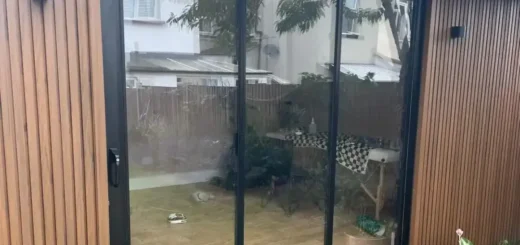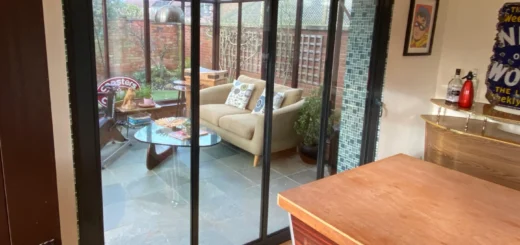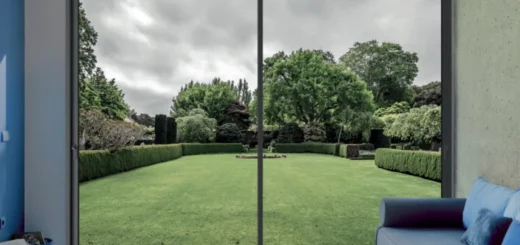Glass Kitchen Doors Types and Design Ideas
Table of Contents
Finding Your Perfect Glass Kitchen Doors
Glass kitchen doors blur the boundaries between your cooking space and adjacent rooms or garden, while letting natural light flood in. Each type works differently in practice – what might suit a compact galley layout could prove impractical in a large open-plan space.
Sliding Glass Kitchen Doors
Modern sliding glass kitchen doors move smoothly along precision-engineered tracks, requiring no swing space to open. The panels stack neatly behind one another, making them ideal for kitchen extension sliding doors where space is limited. Most systems feature double or triple tracks, allowing you to partially open sections for ventilation while maintaining security.
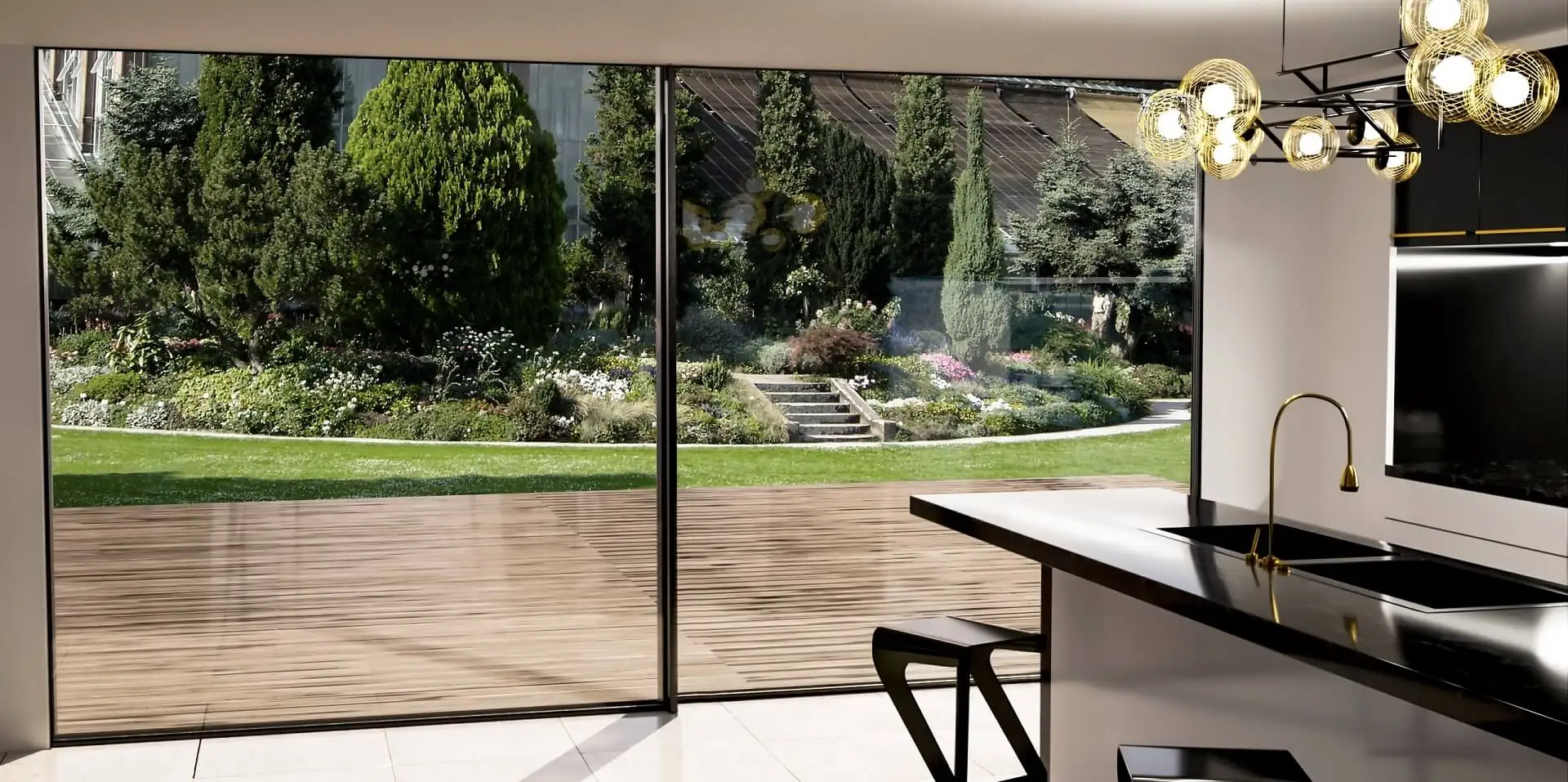
Unlike hinged options, sliding doors don’t catch in strong winds or take up valuable floor area when open. The glass panels themselves can span from floor to ceiling, with slim frames that barely interrupt views. For internal divisions between kitchen and living spaces, sliding systems offer excellent sound insulation when closed.
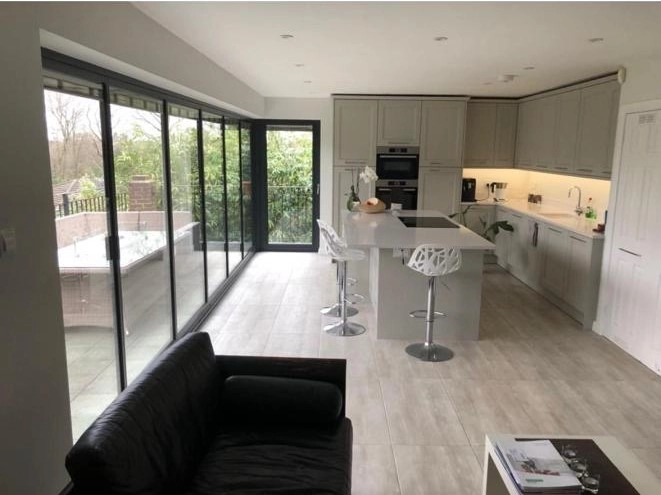
Bifolding Doors for Kitchens
Kitchen bifold doors accordion neatly to one or both sides when opened, creating wide access points between spaces. The folding mechanism allows for more flexible arrangements than sliding systems – you might choose to have three panels folding left and one sliding right, for instance.
The frames on bifold glass kitchen doors contain more vertical elements than sliding versions, which can either work as striking design features or slightly obstruct views. Their multi-panel design offers good ventilation control, as you can open just one or two panels rather than sliding a large heavy pane.
French Doors in Kitchen Spaces
Traditional French doors bring classical character to kitchen spaces while providing generous access. The symmetrical double-door design suits period properties particularly well, though modern interpretations work equally in contemporary settings. Kitchen doors with glass in this style typically feature multiple panes rather than single sheets, creating visual interest through their grid patterns.
Slide and Turn Systems
Breaking away from conventional door designs, slide and turn doors combine the best aspects of sliding and pivoting systems. Each panel moves independently along the track before rotating out of the way. This flexibility lets you create partial openings anywhere along the run, unlike bifolds that need clearing from one end.
Making the Right Choice
Your choice between these glass kitchen door styles should stem from practical factors like available space and usage patterns rather than aesthetics alone. Think about weather exposure, traffic flow through your kitchen, and how often you’ll want to open the doors fully versus having them partially open for ventilation.
Designing with Glass Kitchen Doors
Glass kitchen doors change how you live in and use your space, bringing in more daylight while giving you control over how separate or connected your rooms feel. Good design involves balancing practical needs with your home’s character.

Working with Small Spaces
Compact kitchens gain an extra dimension when fitted with glass kitchen doors. Sliding systems prove particularly useful here – the panels move parallel to the wall instead of swinging out into precious floor space.
When deciding between different types, remember that folding doors need clearance to stack, while sliding mechanisms simply glide behind one another.
Natural light makes modest dimensions feel more generous, especially when glass stretches from floor to ceiling. Dark corners brighten up, worktops become more usable, and the whole room feels more inviting. Internal glass kitchen doors between a kitchen and dining room can make each space feel larger while keeping cooking smells contained when needed.
Black Frames vs Frameless
Frame design shapes the entire look of your kitchen glass doors. Black-framed systems create bold geometric patterns that draw the eye, working beautifully with industrial-style pendant lights and matt black hardware. The strong lines can anchor a large expanse of glass, giving it presence and personality.
Frameless designs take a different approach, almost disappearing from view. Without visible frames, the glass seems to float in place, making the divide between spaces subtle. This minimal look suits ultra-contemporary kitchens where clean lines matter most.
Privacy
Glass kitchen doors don’t mean sacrificing privacy. Sliding doors with integrated blinds offer a neat answer – the blinds sit protected between the glass panels, never needing dusting. These systems let you adjust the level of screening throughout the day while keeping the clean lines of your doors.
Sandblasted or acid-etched glass creates permanent privacy without blocking light. Patterns can range from full frost to decorative designs, letting you mask views while maintaining the bright, open feel that makes glass doors so appealing. Some manufacturers offer graduated frosting that becomes more opaque towards the bottom of the door.
Balancing Light and Privacy
Strategic placement of cabinets, islands, or plants helps manage sight lines through glass kitchen doors without compromising their benefits. A well-positioned kitchen island can shield food preparation areas from view while leaving dining spaces open to the garden. Thoughtful zoning like this maintains privacy naturally.
Bright Ideas for Dark Kitchens
North-facing kitchens or spaces overshadowed by neighbouring buildings particularly benefit from glass kitchen doors. Every bit of available light becomes precious here. Clear glass with minimal framing captures the most light, while reflective surfaces in the kitchen bounce it deeper into the room.
Morning sun through east-facing glass doors fills the kitchen with energising natural light when you need it most. West-facing installations catch evening light, extending the useful hours of natural illumination. The orientation of your doors should match when you use the kitchen most.
Artificial lighting needs careful planning around glass doors. Down lights near the glass can create reflections that spoil the view out after dark. Instead, indirect lighting or wall sconces provide ambience without glare. Task lighting under cabinets ensures work areas stay practical regardless of natural light levels.
Glass Kitchen Doors for Different Home Styles
Glass kitchen doors need to match your home’s architectural style and period features while meeting modern living requirements. The right design adds character rather than clashing with existing elements.
Modern Open-Plan Living
Open-concept spaces become more practical with well-placed glass kitchen doors. Internal concertina doors let you divide areas when needed – perfect for containing cooking aromas or creating quieter zones without losing the spacious feel. The flexibility to open fully or partially means you can adapt the space as activities change throughout the day.
Raw materials like exposed brick or concrete pair naturally with minimalist glass kitchen doors. Simple frame designs in neutral colours complement these industrial touches without competing for attention. The clean lines of modern kitchen cabinets often echo the sleek profiles of contemporary door frames, creating visual harmony.
Large contemporary kitchens benefit from door systems that operate smoothly even at substantial sizes. Multi-panel installations spanning entire walls need robust mechanisms and precise construction to maintain easy operation year after year. Quality hardware makes daily use effortless, while proper sealing keeps the elements out when closed.
Traditional British Homes
Period properties present unique opportunities for glass kitchen doors. Victorian and Edwardian homes often feature high ceilings and grand proportions that work beautifully with tall glass panels. Original features like cornicing or dado rails can inspire the design of new kitchen doors with glass panels, maintaining historical accuracy while adding modern convenience.
Heritage colours on door frames help newer installations settle into older homes. Deep greens, naval blues, or warm greys feel more appropriate than stark modern finishes in traditional settings. Choosing hardware that matches existing door furniture – from brass handles to pewter hinges – helps maintain continuity throughout the house.
Natural Elements
Glass kitchen doors create strong connections with outdoor spaces, making the garden feel like another room. Planting choices near the doors influence the view year-round – evergreen shrubs provide structure in winter, while climbing plants soften hard lines without blocking light. Herbs planted close to kitchen glass doors bring scent and greenery while staying within easy reach for cooking.
Window boxes or container gardens just outside glass kitchen doors add life to the view while screening the base of the frames. Low-maintenance plants like grasses move beautifully in the breeze, creating dynamic views from inside. Seasonal plantings keep the outlook fresh as the months change.
Framing the View
Strategic placement of trees or tall plants creates natural privacy screens without curtains or blinds. Deciduous species let more light through in winter when you need it most, while providing shade in summer. The shifting patterns of leaves and branches add visual interest to the view through your doors.
Lighting Layers
Artificial lighting around glass kitchen doors requires careful thought. Strip lights hidden in door frames wash light down the glass, improving visibility after dark without harsh glare. Dimmer switches let you adjust the mood – bright for food preparation, soft for evening relaxation.
Garden lighting extends the usefulness of glass kitchen doors into evening hours. Up-lights on nearby trees or shrubs create atmosphere while improving security. Path lights guide the eye outward, making the garden an attractive feature even on dark winter afternoons.
Making Glass Kitchen Doors Work Harder
Glass kitchen doors offer more than just access or light – they shape how you move through and use your space each day. Practical details make the difference between doors that suit your lifestyle and those that work against it.
Seasonal Adaptations
Summer brings different demands for glass kitchen doors compared to winter months. Low-e glass helps manage heat levels, reflecting unwanted warmth in July while retaining it during December. Solar control coatings cut glare without darkening the glass, keeping your kitchen comfortable year-round.
Autumn and winter weather patterns might change how you operate your doors. Smaller opening sections prove handy for quick ventilation without letting too much heat escape. Threshold designs that sit flush with indoor and outdoor flooring prevent leaves or rain from being tracked inside.
Modern kitchen styles often incorporate glass doors as central design elements that need to perform throughout changing seasons. Thick double-glazed panels with argon gas filling maintain stable indoor temperatures regardless of outside conditions. Proper drainage channels and robust seals keep British weather where it belongs – outside.
Window Dressing Choices
The right window dressing makes glass kitchen doors more practical without hiding their benefits. Wave-style curtains stack neatly when open, framing rather than overwhelming the glass. Light, natural fabrics filter strong sunlight while maintaining views and adding softness to hard surfaces.
Blinds mounted within the glass eliminate cleaning hassles and never clash with handles or opening mechanisms. For external kitchen glass doors, these integrated systems prove especially useful – no curtains blowing in the breeze or blinds rattling against the glass.
Remote-controlled shading options work well for high-level glass panels or doors in hard-to-reach spots. Motorised systems can link to home automation, adjusting automatically with the sun’s position or at set times. This hands-free operation proves particularly valuable above kitchen sinks or cooking areas.
Privacy Day and Night
Strategic window dressing zones create privacy where needed while keeping other areas open. Cafe-style panels cover only the lower portion of glass kitchen doors, screening food preparation areas while letting in plenty of light from above. This partial coverage works especially well for doors facing neighbouring properties.
Layout Planning
Kitchen layouts need careful planning around glass doors to avoid impractical arrangements. Wall units and tall cabinets placed too close to door frames can limit opening angles or create awkward corners. Allowing enough clearance for comfortable movement prevents daily frustration.
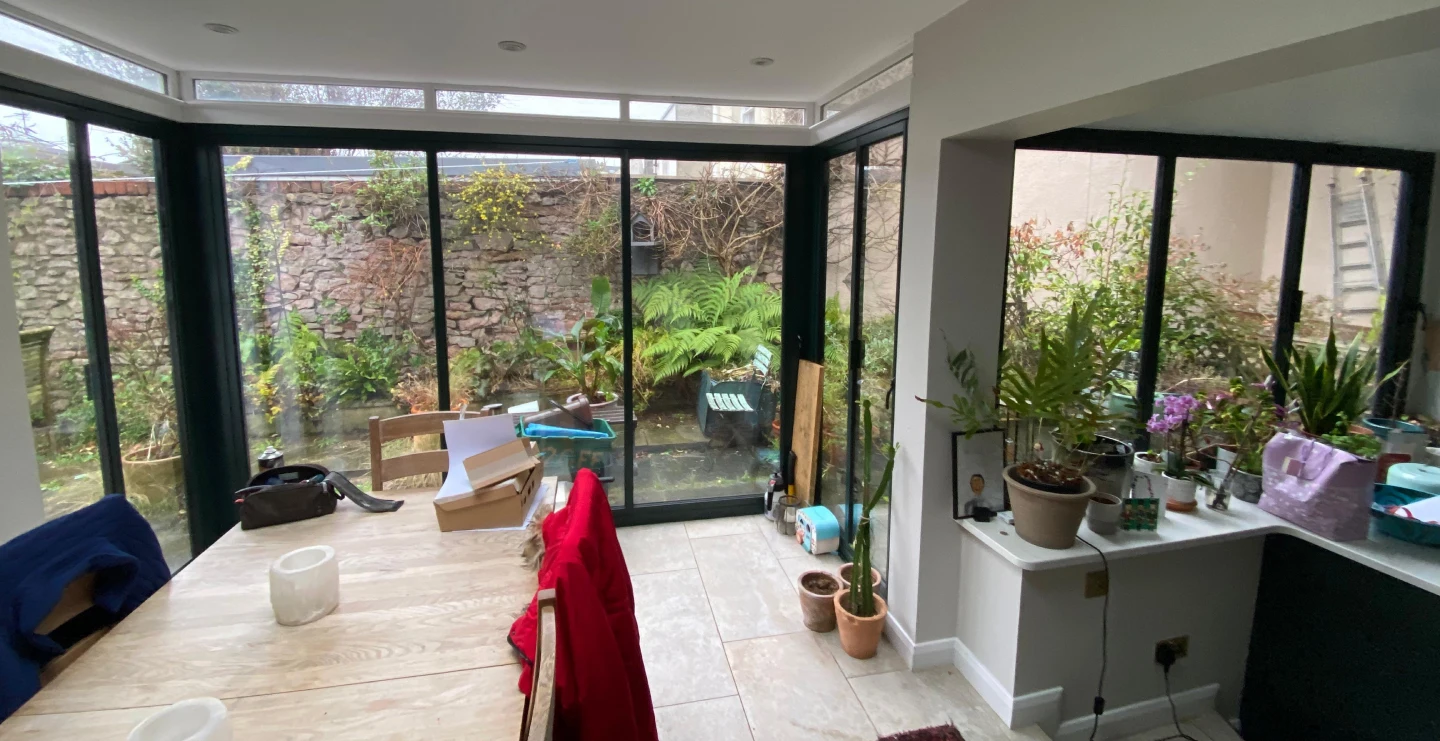
The position of key kitchen features in relation to glass doors matters enormously. Sinks facing the garden make washing up more pleasant, while cooking zones might benefit from more shelter. Islands parallel to glass kitchen doors create natural walking routes without blocking access or views.
Work triangles – the spaces between sink, cooker, and fridge – should flow naturally even when doors stand open. Traffic patterns change when entertaining or dining outdoors, so primary cooking zones work better slightly removed from main thoroughfares. This separation keeps the chef comfortable while guests move between indoor and outdoor spaces.
Sound and Space
Acoustic properties of glass kitchen doors deserve attention, particularly in open-plan areas. Double-glazed panels reduce noise transfer, letting you run the dishwasher without disturbing conversation in adjacent spaces. Specialized acoustic glass offers extra sound reduction where needed.
Room acoustics change when large glass surfaces replace solid walls. Soft furnishings and textured materials help absorb sound that might otherwise bounce between hard surfaces. Area rugs near glass kitchen doors dampen footsteps and add comfort underfoot while defining different zones within the space.
About SunSeeker Doors
With over 20 years of experience, SunSeeker Doors remains at the forefront of door design with our quality-tested patio doors and related products, including the bespoke UltraSlim aluminium slide and pivot door system, Frameless Glass Doors, and Slimline Sliding Glass Doors. All of our doors are suitable for both internal and external use.
To request a free quotation, please use our online form. You may also contact 01582 492730, or email info@sunseekerdoors.co.uk if you have any questions.


